The literature of korea
Download as pptx, pdf7 likes6,309 views
This document provides information on Korean literature and history. It discusses Korea's ancient origins dating back to 2333 BC under the legendary founder Tangun. It then summarizes Korea's unification in the 10th century and rule under the Yi Dynasty from 1392-1910. The document also profiles prominent Korean authors like Yun Seondo, known for his seasonal poetry collection "The Fisherman's Calendar", and painter Yun Tu-so from the late 17th century. In addition, it touches on elements of Korean culture like the Hangul alphabet, celadon pottery, and mask plays.
1 of 21
Downloaded 334 times
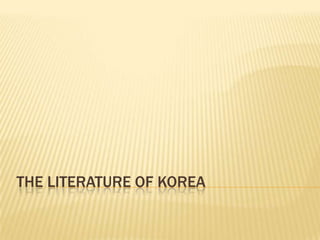
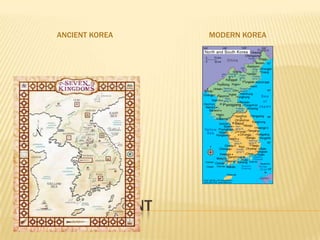
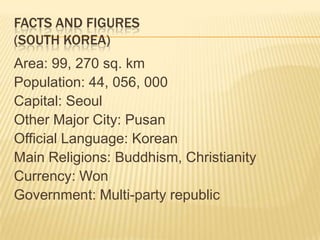



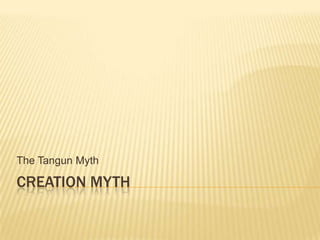

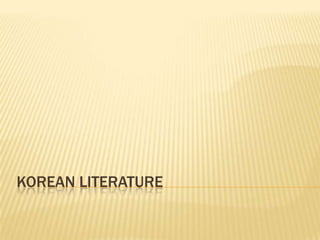
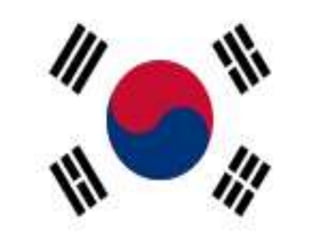
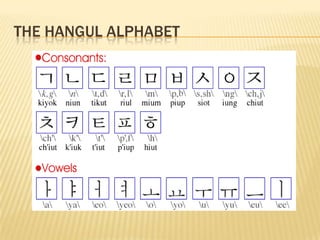
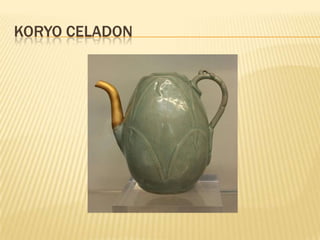
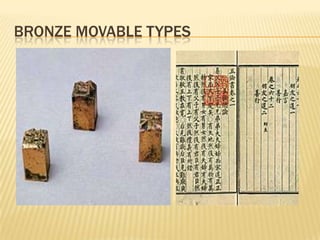
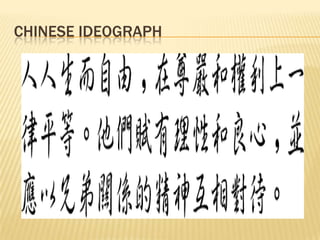
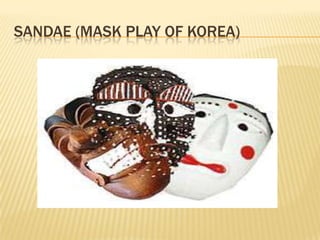
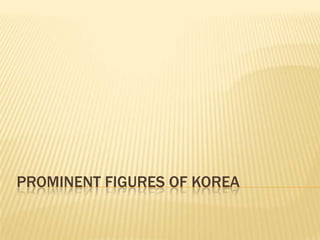
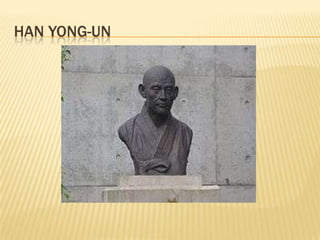
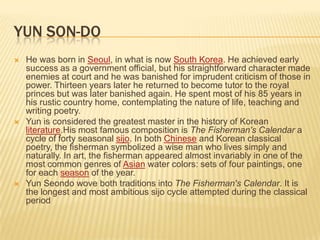
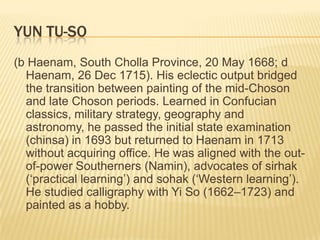
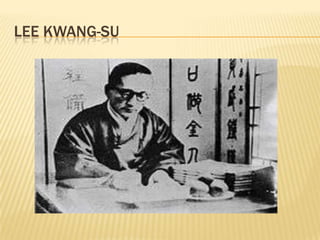
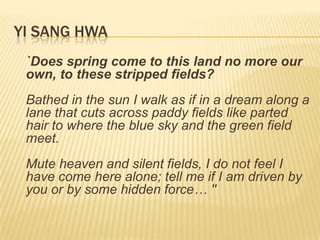
Ad
Recommended
Literature of korea
Literature of koreaReinabelle Castro
╠²
This document provides an overview of Korean literature and history. It discusses:
1) Korea's geography and division between North and South Korea.
2) Brief histories of the kingdoms and dynasties that ruled Korea from the 1300s to 1910.
3) Key facts about Korea such as population, capital, languages, and government.
4) Important figures and genres in Korean literature, including sijo poetry and the creation myth of Tangun.Korean literature
Korean literatureErin Hogshead
╠²
Korean literature developed under the influence of traditional folk beliefs as well as Taoism, Confucianism, and Buddhism. It is often divided into classical and modern periods, though this is questioned due to reforms in the 19th century and Western influence. Key genres include Hyangga poetry from the classical period as well as sijo poetry and Joseon period poetry from the later period when Hangul was promoted. Translations of Korean literature to other languages have increased its global visibility since the 1980s.Korean literature
Korean literature robinreyes15
╠²
The document provides an overview of Korean literature from early oral traditions through modern times. It discusses the influences of Shamanism, Buddhism, and Confucianism on early Korean literature. The hyangga poems of the Shilla period marked the beginning of a unique poetic form. During the Koryo dynasty, hanshi poems and shijo poems developed. The creation of the Korean alphabet in the 15th century allowed literature to broaden beyond the upper classes. Oral traditions like mask plays and pansori singing texts were important before the modern period which began with literary magazines in the 1910s-1930s under Japanese colonial rule.South korea
South koreaAngelyn Lingatong
╠²
Korea is a peninsula located in East Asia that is divided into two sovereign states - North Korea and South Korea. The name "Korea" comes from the name of the Korean kingdom of Goryeo which ruled the peninsula in the Middle Ages. In South Korea, the whole peninsula is referred to as Hanguk, while in North Korea it is referred to as Chosŏn. Korea has a long history and was once divided into three kingdoms during the 1st century AD. In the late 14th century, the Joseon Dynasty united much of Korea and established Seoul as the capital. Korea was then occupied by Japan in the early 20th century and divided after World War 2, leading toKorean literaturehistoryseoul
Korean literaturehistoryseoulchin bounthourn
╠²
Korean literature has been heavily influenced over the centuries by shamanism, Buddhism, Confucianism, Taoism, and Christianity. The early classics were primarily oral and poetic in form due to the lack of a written script, with genres including hyangga poems, pansori narrative songs, and sijo poems. The invention of the Korean alphabet hangul in 1446 helped literature become more widely accessible. Modern Korean literature has explored issues of national identity, the trauma of Japanese colonial rule, and the division of the Korean peninsula following World War 2. Contemporary writers increasingly engage with global themes rather than focusing solely on national concerns.Masterpieces of korean literature
Masterpieces of korean literature Kathleen Paras
╠²
The document summarizes several important works in Korean literature, including the first Korean novel "The Story of Hong Kiltong" by Ho Kyun, the first Korean lyric poem "Orioles' Song" from 17 BCE, and "History of the Three Kingdoms", Korea's first historical work from 1146 CE which used early modern historiographic techniques. It also mentions the dynastic poem "Songs of Flying Dragons", the court memoir "Record of Sorrowful Days" written by a Korean princess, the famous folk tale "Spring Fragrance", and Pak Kyong-ni's 21-volume national epic "Land".Korean literature
Korean literatureMa Lovely
╠²
The document provides information about Korean literature and culture. It discusses the geography of the Korean peninsula and its division into North and South Korea. It then summarizes some key aspects of each country, including their education systems, languages, cuisines, sports, music, traditional clothing, architecture, and historical dynasties. The document also outlines the development of Korean literature from early classical works to its flourishing in modern times, noting influence from Buddhism, Confucianism and periods of colonial rule and war.Korean literature Group4 12-Modeller
Korean literature Group4 12-Modelleremem betiong
╠²
Korean literature developed over thousands of years, originally being written in Chinese characters before the invention of Hangul in the 15th century. Some major traditional poetic forms of Korean literature include hyangga, pyolgok, changga, and sijo. Korea is now separated into two countries, North and South Korea, after being divided following World War 2 along ideological lines, with the North becoming communist under Russian influence and the South becoming democratic with American involvement.Korean literature
Korean literatureladybug10
╠²
The document provides an overview of Korean literature, detailing its historical development from classical Chinese writing to the creation of Hangul by Sejong the Great in 1446. It categorizes Korean literary forms, including traditional poetry such as Hyangga, Sijo, and Kasa, and discusses the influence of Buddhism, shamanism, and Confucianism on the literature. The evolution of prose and fiction in Korea, including notable works and movements, is also highlighted, particularly during the Goryeo and Joseon dynasties.Japanese literature
Japanese literatureHyacinth Baldado
╠²
Japan is also known as the Land of the Rising Sun. Its capital city is Tokyo. The four main forms of Japanese poetry are kanshi, waka, tanka, and haiku. Haiku are 3-line verses with a 5-7-5 pattern. The periods of Japanese literature include the Nara, Heian, Cloistered Rule, Kamakura, Nanboku-cho, Sengoku, and Pre-Modern periods. The Nara period established the Great Buddha at Todai-ji temple in Nara by order of Emperor Shomu. History of East Asian Literature
History of East Asian LiteratureJuan Miguel Palero
╠²
Chinese and Japanese literature are the most prominent forms of East Asian literature, with early influences from oral traditions and notable historical texts like the Shiji and Zuo Zhuan. The evolution of literature includes significant developments during the Tang and Song dynasties in China and the Heian and Edo periods in Japan, showcasing a blend of traditional and innovative styles. The Meiji period further transformed Japanese literature by incorporating European influences and fostering debates around literary definitions.Chinese literature final
Chinese literature finalIgnatius Joseph Estroga
╠²
The document provides information about China's flag, geography, demographics, culture, history, and traditions. The flag of China was adopted in 1949 and features five stars - one large star representing communism and four smaller stars representing social classes. China has a population of over 1.3 billion people and is located in East Asia, bordering the Pacific Ocean. The main ethnic group is Han Chinese and the primary language is Mandarin Chinese. Key aspects of Chinese culture discussed include Confucianism, Taoism, Buddhism, festivals like Chinese New Year and Mid-Autumn Festival, cuisine emphasizing vegetables, and a historical emphasis on education.Korean literature
Korean literatureAbbie Laudato
╠²
Early Korean literature was heavily influenced by Shamanism, Buddhism, and Confucianism. It began as an oral tradition and emphasized moral values like loyalty, filial piety, and respect. The first Korean writings were poems called hyangga during the Shilla Kingdom. Literature continued to develop over the Goryeo and Joseon Dynasties, with the creation of hangul allowing for a broader range of works and audiences. Major genres included shijo poetry, p'ansori oral epics, and fiction written in both Chinese and hangul that increasingly featured common people.Chinese literature
Chinese literaturerodylyn velasquez
╠²
The document provides information on various topics related to China, including:
1. The flag of China represents communism and the social classes of the Chinese people. Beijing is the capital city located in eastern Asia.
2. Beijing has a history stretching back 3 millennia and is known for modern architecture like Tiananmen Square as well as ancient sites like the Forbidden City. The Great Wall of China stretches over 6,700 km and was built for defense.
3. Chinese culture includes religions like Islam, Catholicism, and Buddhism. Traditional weddings are red and involve astrological matching. Education has always been highly valued in China dating back to Confucius.AFRO-AMERICAN LITERATURE
AFRO-AMERICAN LITERATURERabia Khan
╠²
The document summarizes a presentation given by a group of students on Afro-American literature and the Harlem Renaissance. It discusses Langston Hughes' poems "Dream" and "Harlem" and their themes of unfulfilled dreams. It provides biographical details about Hughes and analyzes the literary devices used in the poems, including personification, metaphor, alliteration and simile.Introduction to Japanese Literature
Introduction to Japanese Literatureangelica pilias
╠²
Japan has a rich cultural history reflected in its styles, literature, and ceremonies. Traditional Japanese clothing like kimonos and yukatas are now typically worn only for special occasions. Japanese literature is one of the major literatures of the world and includes classic works like The Tale of Genji from the 11th century. Traditional ceremonies in Japan mark important life events from birth to death as well as seasonal festivals celebrating harvests.Japanese literature
Japanese literatureKenneth Osabal
╠²
Japan has a long history of unique cultural traditions that are reflected in its literature, art, and ceremonies. Japanese literature dates back to at least the 8th century AD and includes notable works like the Man'yoshu poetry anthology and Murasaki Shikibu's 11th century novel The Tale of Genji. Traditional Japanese ceremonies like the tea ceremony, weddings, and funerals follow customs that are deeply rooted in Japanese cultural heritage. Festivals also incorporate contests demonstrating artistic and literary skills that have been part of Japanese culture for centuries.Japanese literature
Japanese literatureIgnatius Joseph Estroga
╠²
This document provides an overview of Japan, including its flag, geography, population, climate, culture, and traditions. The Japanese flag features a red circle representing the sun on a white background, symbolizing peace and honesty. Japan consists of several thousand islands including Honshu, Hokkaido, Kyushu, and Shikoku. The country has over 125 million residents and experiences frequent earthquakes. Japanese culture incorporates Shinto and Buddhist traditions as well as seasonal festivals and weddings involving both traditional and modern customs.Japanese Literature
Japanese LiteratureMYDA ANGELICA SUAN
╠²
Japanese literature has a long history dating back to the Yamato/Kofun period in the 3rd-8th centuries CE. Major developments include the introduction of Chinese writing, Buddhism, and Confucianism during this time. The Tale of Genji, written by Murasaki Shikibu in the early 11th century, is considered the world's first novel and provides insights into aristocratic Heian period culture and society. Traditional Japanese genres that developed include haiku poetry, Noh drama, and Kabuki theater. Modern Japanese media like anime and films continue to be influenced by traditional literary and artistic forms.Things fall apart Study Notes
Things fall apart Study Notes DarleneKSinanan
╠²
Things Fall Apart by Chinua Achebe is set in 1890s Nigeria and depicts the clash between European colonialism and Igbo culture. The main character, Okonkwo, strives to be the opposite of his father through hard work and masculinity defined by aggression, anger, and violence. However, his tragic flaw leads to his downfall when he kills a clansman, violating the Week of Peace. The novel explores Igbo traditions and oral storytelling, as well as the differing perspectives of Okonkwo, his son Nwoye, and daughter Ezinma on masculinity and the arrival of European missionaries.Japanese literature
Japanese literatureMa. Julie Anne Gajes
╠²
Japanese literature spans almost two millennia and evolved significantly over time. It was initially influenced by Chinese literature but developed a distinct style. The earliest works were the Kojiki and Nihon Shoki chronicles in the 8th century, while the 11th century Tale of Genji by Murasaki Shikibu is considered a masterpiece. Medieval literature reflected Zen Buddhism and the rise of warriors. Popular genres like kabuki drama flourished in the Edo period alongside haiku and novels. The Meiji period saw Western influences and debate over the modernization of language in literature.Korean-Literature1.pptx
Korean-Literature1.pptxMareaKeishaFayethFer
╠²
Korean literature has a history spanning over 1,500 years. Some of the earliest forms of Korean poetry include hyangga and Goryeo songs, which were often meant to be sung. Major poetic forms that developed include sijo, gasa, and hyangga. Prose literature includes myths, legends, and folktales found in historical texts. The development of hangul in the 15th century allowed the flowering of vernacular Korean literature forms like sijo and gasa. Modern Korean literature emerged in the late 19th century during the enlightenment period.Japanese Literature
Japanese LiteratureCherish Angelic Mondilla
╠²
The document outlines the evolution of Japanese literature across various periods, highlighting key works and their historical significance from ancient texts like 'Kojiki' and 'Nihongi' to modern authors such as Kawabata Yasunari. It discusses the characteristics of different literary styles and genres, including poetry forms like tanka and haiku, and the impact of foreign influences during the Meiji period. Additionally, it examines the thematic depth in post-war literature, reflecting on emotional issues and national identity.Grade 8 Japanese Literature
Grade 8 Japanese LiteratureTalugtug National High School
╠²
Japan has a rich cultural heritage that is reflected in its traditional styles of clothing like kimonos and yukatas, architecture and gardens, and literature. Some key aspects of Japanese culture mentioned include the 11th century novel The Tale of Genji, considered the earliest novel ever written; haiku and Noh drama as influential literary genres; and traditional ceremonies like weddings, births and tea ceremonies that are still practiced today with cultural significance. Festivals also involve contests demonstrating skills in athletics, poetry and art.Arabian literature ppt
Arabian literature pptshara anacay
╠²
The document discusses Arabian literature and culture, outlining the geography, history, and key elements of the region. It highlights important figures such as Muhammad and literary works like 'One Thousand and One Nights,' while also considering contemporary themes like secular versus fundamentalist interpretations of Islam. Additionally, it addresses various forms of artistic expression, including storytelling and poetry, within the context of Islamic traditions.Contemporary poetry
Contemporary poetryIanWilliams92
╠²
The document discusses contemporary poetry, defining it as poetry written after the 1920s characterized by traits like free verse, irregular meter, and a deviation from traditional forms. It explores the historical context, significance of free verse, and the qualities that contribute to 'good' poetry, emphasizing the expressive potential of this style. Additionally, it outlines an assignment requiring students to write two free verse poems incorporating various poetic tools and personal applications.Sri lanka
Sri lankaranjannitc
╠²
Sri Lanka gained independence from British rule in 1948. It has a population of over 20 million and its capital and largest city is Sri Jayawardenapura Kotte. Sri Lanka has a diverse landscape that includes rainforests, coastal areas, and inland plains. It has a long history and was known as Ceylon under British rule. Sri Lanka has a predominantly Buddhist population and Buddhism has had a significant influence on the country's culture and heritage. The economy has shifted from agriculture to services and industries like tourism and tea production remain important.21st Century Singaporean Literature Presentation
21st Century Singaporean Literature Presentationlalizegou
╠²
Singapore has four official languages due to its multicultural population. Literature in Singapore is composed of works in English, Chinese, Malay, and Tamil. Some notable Singaporean writers include Kou Pao Kun, Goh Poh Seng, Francis P. Ng, and Catherine Lim. Kou Pao Kun wrote plays that featured multiculturalism and social commentary themes, while Goh Poh Seng and Francis P. Ng published poetry and novels that explored Singaporean identity. Catherine Lim's works often examined Asian male dominance.Korea
Koreanikkibarts16
╠²
Korea has a long history dating back thousands of years. It was originally comprised of three kingdoms - Goguryeo, Baekje, and Silla. Silla eventually unified the peninsula under its rule. The Goryeo dynasty then took over and established Korea's name. During the Joseon dynasty, Confucianism and the Korean alphabet were adopted. Korea suffered invasions from Japan and Manchu China before becoming annexed by Japan in 1910. After World War 2, Korea was divided along the 38th parallel, eventually leading to the establishment of North and South Korea and the Korean War.South Korea
South KoreaJhaly Acacio
╠²
South Korea, officially the Republic of Korea, is located in East Asia on the southern part of the Korean Peninsula, sharing borders with North Korea, China, and Japan. The country's history includes a rich monarchical past, a devastating Korean War, and a current status as one of the world's wealthiest nations with a diverse culture that combines traditional and modern elements. Significant cultural aspects include traditional clothing like hanbok, an extensive literary heritage, and the flourishing of Korean pop culture, known as the Korean Wave.More Related Content
What's hot (20)
Korean literature
Korean literatureladybug10
╠²
The document provides an overview of Korean literature, detailing its historical development from classical Chinese writing to the creation of Hangul by Sejong the Great in 1446. It categorizes Korean literary forms, including traditional poetry such as Hyangga, Sijo, and Kasa, and discusses the influence of Buddhism, shamanism, and Confucianism on the literature. The evolution of prose and fiction in Korea, including notable works and movements, is also highlighted, particularly during the Goryeo and Joseon dynasties.Japanese literature
Japanese literatureHyacinth Baldado
╠²
Japan is also known as the Land of the Rising Sun. Its capital city is Tokyo. The four main forms of Japanese poetry are kanshi, waka, tanka, and haiku. Haiku are 3-line verses with a 5-7-5 pattern. The periods of Japanese literature include the Nara, Heian, Cloistered Rule, Kamakura, Nanboku-cho, Sengoku, and Pre-Modern periods. The Nara period established the Great Buddha at Todai-ji temple in Nara by order of Emperor Shomu. History of East Asian Literature
History of East Asian LiteratureJuan Miguel Palero
╠²
Chinese and Japanese literature are the most prominent forms of East Asian literature, with early influences from oral traditions and notable historical texts like the Shiji and Zuo Zhuan. The evolution of literature includes significant developments during the Tang and Song dynasties in China and the Heian and Edo periods in Japan, showcasing a blend of traditional and innovative styles. The Meiji period further transformed Japanese literature by incorporating European influences and fostering debates around literary definitions.Chinese literature final
Chinese literature finalIgnatius Joseph Estroga
╠²
The document provides information about China's flag, geography, demographics, culture, history, and traditions. The flag of China was adopted in 1949 and features five stars - one large star representing communism and four smaller stars representing social classes. China has a population of over 1.3 billion people and is located in East Asia, bordering the Pacific Ocean. The main ethnic group is Han Chinese and the primary language is Mandarin Chinese. Key aspects of Chinese culture discussed include Confucianism, Taoism, Buddhism, festivals like Chinese New Year and Mid-Autumn Festival, cuisine emphasizing vegetables, and a historical emphasis on education.Korean literature
Korean literatureAbbie Laudato
╠²
Early Korean literature was heavily influenced by Shamanism, Buddhism, and Confucianism. It began as an oral tradition and emphasized moral values like loyalty, filial piety, and respect. The first Korean writings were poems called hyangga during the Shilla Kingdom. Literature continued to develop over the Goryeo and Joseon Dynasties, with the creation of hangul allowing for a broader range of works and audiences. Major genres included shijo poetry, p'ansori oral epics, and fiction written in both Chinese and hangul that increasingly featured common people.Chinese literature
Chinese literaturerodylyn velasquez
╠²
The document provides information on various topics related to China, including:
1. The flag of China represents communism and the social classes of the Chinese people. Beijing is the capital city located in eastern Asia.
2. Beijing has a history stretching back 3 millennia and is known for modern architecture like Tiananmen Square as well as ancient sites like the Forbidden City. The Great Wall of China stretches over 6,700 km and was built for defense.
3. Chinese culture includes religions like Islam, Catholicism, and Buddhism. Traditional weddings are red and involve astrological matching. Education has always been highly valued in China dating back to Confucius.AFRO-AMERICAN LITERATURE
AFRO-AMERICAN LITERATURERabia Khan
╠²
The document summarizes a presentation given by a group of students on Afro-American literature and the Harlem Renaissance. It discusses Langston Hughes' poems "Dream" and "Harlem" and their themes of unfulfilled dreams. It provides biographical details about Hughes and analyzes the literary devices used in the poems, including personification, metaphor, alliteration and simile.Introduction to Japanese Literature
Introduction to Japanese Literatureangelica pilias
╠²
Japan has a rich cultural history reflected in its styles, literature, and ceremonies. Traditional Japanese clothing like kimonos and yukatas are now typically worn only for special occasions. Japanese literature is one of the major literatures of the world and includes classic works like The Tale of Genji from the 11th century. Traditional ceremonies in Japan mark important life events from birth to death as well as seasonal festivals celebrating harvests.Japanese literature
Japanese literatureKenneth Osabal
╠²
Japan has a long history of unique cultural traditions that are reflected in its literature, art, and ceremonies. Japanese literature dates back to at least the 8th century AD and includes notable works like the Man'yoshu poetry anthology and Murasaki Shikibu's 11th century novel The Tale of Genji. Traditional Japanese ceremonies like the tea ceremony, weddings, and funerals follow customs that are deeply rooted in Japanese cultural heritage. Festivals also incorporate contests demonstrating artistic and literary skills that have been part of Japanese culture for centuries.Japanese literature
Japanese literatureIgnatius Joseph Estroga
╠²
This document provides an overview of Japan, including its flag, geography, population, climate, culture, and traditions. The Japanese flag features a red circle representing the sun on a white background, symbolizing peace and honesty. Japan consists of several thousand islands including Honshu, Hokkaido, Kyushu, and Shikoku. The country has over 125 million residents and experiences frequent earthquakes. Japanese culture incorporates Shinto and Buddhist traditions as well as seasonal festivals and weddings involving both traditional and modern customs.Japanese Literature
Japanese LiteratureMYDA ANGELICA SUAN
╠²
Japanese literature has a long history dating back to the Yamato/Kofun period in the 3rd-8th centuries CE. Major developments include the introduction of Chinese writing, Buddhism, and Confucianism during this time. The Tale of Genji, written by Murasaki Shikibu in the early 11th century, is considered the world's first novel and provides insights into aristocratic Heian period culture and society. Traditional Japanese genres that developed include haiku poetry, Noh drama, and Kabuki theater. Modern Japanese media like anime and films continue to be influenced by traditional literary and artistic forms.Things fall apart Study Notes
Things fall apart Study Notes DarleneKSinanan
╠²
Things Fall Apart by Chinua Achebe is set in 1890s Nigeria and depicts the clash between European colonialism and Igbo culture. The main character, Okonkwo, strives to be the opposite of his father through hard work and masculinity defined by aggression, anger, and violence. However, his tragic flaw leads to his downfall when he kills a clansman, violating the Week of Peace. The novel explores Igbo traditions and oral storytelling, as well as the differing perspectives of Okonkwo, his son Nwoye, and daughter Ezinma on masculinity and the arrival of European missionaries.Japanese literature
Japanese literatureMa. Julie Anne Gajes
╠²
Japanese literature spans almost two millennia and evolved significantly over time. It was initially influenced by Chinese literature but developed a distinct style. The earliest works were the Kojiki and Nihon Shoki chronicles in the 8th century, while the 11th century Tale of Genji by Murasaki Shikibu is considered a masterpiece. Medieval literature reflected Zen Buddhism and the rise of warriors. Popular genres like kabuki drama flourished in the Edo period alongside haiku and novels. The Meiji period saw Western influences and debate over the modernization of language in literature.Korean-Literature1.pptx
Korean-Literature1.pptxMareaKeishaFayethFer
╠²
Korean literature has a history spanning over 1,500 years. Some of the earliest forms of Korean poetry include hyangga and Goryeo songs, which were often meant to be sung. Major poetic forms that developed include sijo, gasa, and hyangga. Prose literature includes myths, legends, and folktales found in historical texts. The development of hangul in the 15th century allowed the flowering of vernacular Korean literature forms like sijo and gasa. Modern Korean literature emerged in the late 19th century during the enlightenment period.Japanese Literature
Japanese LiteratureCherish Angelic Mondilla
╠²
The document outlines the evolution of Japanese literature across various periods, highlighting key works and their historical significance from ancient texts like 'Kojiki' and 'Nihongi' to modern authors such as Kawabata Yasunari. It discusses the characteristics of different literary styles and genres, including poetry forms like tanka and haiku, and the impact of foreign influences during the Meiji period. Additionally, it examines the thematic depth in post-war literature, reflecting on emotional issues and national identity.Grade 8 Japanese Literature
Grade 8 Japanese LiteratureTalugtug National High School
╠²
Japan has a rich cultural heritage that is reflected in its traditional styles of clothing like kimonos and yukatas, architecture and gardens, and literature. Some key aspects of Japanese culture mentioned include the 11th century novel The Tale of Genji, considered the earliest novel ever written; haiku and Noh drama as influential literary genres; and traditional ceremonies like weddings, births and tea ceremonies that are still practiced today with cultural significance. Festivals also involve contests demonstrating skills in athletics, poetry and art.Arabian literature ppt
Arabian literature pptshara anacay
╠²
The document discusses Arabian literature and culture, outlining the geography, history, and key elements of the region. It highlights important figures such as Muhammad and literary works like 'One Thousand and One Nights,' while also considering contemporary themes like secular versus fundamentalist interpretations of Islam. Additionally, it addresses various forms of artistic expression, including storytelling and poetry, within the context of Islamic traditions.Contemporary poetry
Contemporary poetryIanWilliams92
╠²
The document discusses contemporary poetry, defining it as poetry written after the 1920s characterized by traits like free verse, irregular meter, and a deviation from traditional forms. It explores the historical context, significance of free verse, and the qualities that contribute to 'good' poetry, emphasizing the expressive potential of this style. Additionally, it outlines an assignment requiring students to write two free verse poems incorporating various poetic tools and personal applications.Sri lanka
Sri lankaranjannitc
╠²
Sri Lanka gained independence from British rule in 1948. It has a population of over 20 million and its capital and largest city is Sri Jayawardenapura Kotte. Sri Lanka has a diverse landscape that includes rainforests, coastal areas, and inland plains. It has a long history and was known as Ceylon under British rule. Sri Lanka has a predominantly Buddhist population and Buddhism has had a significant influence on the country's culture and heritage. The economy has shifted from agriculture to services and industries like tourism and tea production remain important.21st Century Singaporean Literature Presentation
21st Century Singaporean Literature Presentationlalizegou
╠²
Singapore has four official languages due to its multicultural population. Literature in Singapore is composed of works in English, Chinese, Malay, and Tamil. Some notable Singaporean writers include Kou Pao Kun, Goh Poh Seng, Francis P. Ng, and Catherine Lim. Kou Pao Kun wrote plays that featured multiculturalism and social commentary themes, while Goh Poh Seng and Francis P. Ng published poetry and novels that explored Singaporean identity. Catherine Lim's works often examined Asian male dominance.Viewers also liked (7)
Korea
Koreanikkibarts16
╠²
Korea has a long history dating back thousands of years. It was originally comprised of three kingdoms - Goguryeo, Baekje, and Silla. Silla eventually unified the peninsula under its rule. The Goryeo dynasty then took over and established Korea's name. During the Joseon dynasty, Confucianism and the Korean alphabet were adopted. Korea suffered invasions from Japan and Manchu China before becoming annexed by Japan in 1910. After World War 2, Korea was divided along the 38th parallel, eventually leading to the establishment of North and South Korea and the Korean War.South Korea
South KoreaJhaly Acacio
╠²
South Korea, officially the Republic of Korea, is located in East Asia on the southern part of the Korean Peninsula, sharing borders with North Korea, China, and Japan. The country's history includes a rich monarchical past, a devastating Korean War, and a current status as one of the world's wealthiest nations with a diverse culture that combines traditional and modern elements. Significant cultural aspects include traditional clothing like hanbok, an extensive literary heritage, and the flourishing of Korean pop culture, known as the Korean Wave.South Korea Presentation
South Korea PresentationNational University of Singapore
╠²
South Korea has around 50 million people mostly living in dense urban areas. Its economy relies heavily on electronics, automotive, shipbuilding and petrochemical exports, driven by large conglomerates like Samsung and LG as well as the government's investment in education and technology. South Korean culture places great emphasis on education, hard work, collectivism and maintaining social harmony.Introducing Korea!
Introducing Korea!Lisa Pennington
╠²
The document provides an overview of Korea, covering its location, traditional clothing (like the hanbok), food (including rice and kimchi), popular sports (such as baseball and tae kwon do), and the education system, which emphasizes hard work and long hours. It highlights cultural aspects and compares them to the United States. Overall, it aims to introduce the unique features of Korean life and customs.Korean culture
Korean culturePRESENTATIONSFORESL
╠²
Korean culture has a long history dating back over 4,000 years, shaped by major invasions and wars over the past 2,000 years. Religions like Shamanism, Buddhism, Daoism, and Confucianism have historically influenced Koreans, and traditional clothing, music, and cuisine remain important parts of Korean culture today.Korean culture
Korean culturebunar
╠²
Korean culture has many elements including rich cuisine. Traditional Korean meals usually consist of rice, noodles, soup and fish served together family style. Music is also an important part of Korean culture, featuring instruments like the gayageum, geomungo and yanggeum. Buddhism is the most common religion, and Koreans honor deceased loved ones with memorial meals and ceremonies over several days.The Republic Of South Korea
The Republic Of South Koreaorangetreeworks
╠²
South Korea, officially known as Dae-Han-Min-Guk, has transformed from a historically occupied nation to a global economic power, recovering from a tumultuous 20th century marked by Japanese rule and the Korean War. The country boasts significant urban populations, a thriving economy led by major brands like Samsung and Hyundai, and a rich cultural heritage reflected in its cuisine, education, and family values. As South Korea continues to modernize, it faces challenges such as a divided peninsula and an evolving demographic landscape due to increasing foreign populations.Ad
Similar to The literature of korea (20)
southkorea-140517233532-phpapp02.pdf
southkorea-140517233532-phpapp02.pdfJJRoxas2
╠²
South Korea is located in East Asia, occupying the southern half of the Korean Peninsula. It shares land borders with North Korea and sea borders with China and Japan. The capital and largest city is Seoul, with other major cities including Busan, Daegu, Daejeon, Gwangju, Incheon, and Ulsan. South Korea has a population of around 49 million and a growing economy that is highly developed and ranks among the top 15 in the world. The country has a long history and was once comprised of independent kingdoms before being united. Key landmarks include palaces, temples, and natural areas like Jeju Island. South Korean culture is reflected in traditions like hanbok clothing, hanji paper1theoriginsofkorea1 150915215935-lva1-app6892
1theoriginsofkorea1 150915215935-lva1-app6892csolitude
╠²
The document discusses the origins and early history of Korea. It describes evidence of early humans dating back 400,000 years and the development of pottery styles between 6000-2000 BCE. The Bronze and Iron Ages introduced new technologies from China. Significant archaeological sites from 100 BCE include megalithic dolmens that indicate social stratification. The document also summarizes the Tangun founding myth, where the bear-woman gave birth to Tangun, who established the first Korean state of Old Joseon in 2333 BCE.Final S S Presentation2
Final S S Presentation2itennyo
╠²
Southeast Asia is a region located between the Indian and Pacific Oceans, made up of a mainland peninsula and surrounding islands. The geography of rivers, hills, mountains and islands separated different cultures and languages over centuries. Local lords controlled important trade routes and ports, charging merchants high fees. Beginning in the 1st century AD, Indian culture significantly influenced religion, language and art in Southeast Asia through merchants and missionaries.Korea ppt-pre-modern korea
Korea ppt-pre-modern koreaJini Shim
╠²
This document provides an overview of Korean history from prehistoric times through the Goryeo dynasty. It describes how the early Koreans migrated to the Korean peninsula around 4000 BCE and engaged in agriculture. It then outlines the three kingdoms period where Goguryeo, Baekje, and Silla emerged as independent states influenced by but not controlled by China. Silla eventually unified the peninsula and experienced a golden age under Queen Sondok's rule before declining. The Goryeo dynasty then ruled for nearly five centuries, achieving advances in Buddhism, arts, and inventing movable metal printing type centuries before Gutenberg.Korean Literature.pptx Report for Aphro-Asia Class
Korean Literature.pptx Report for Aphro-Asia ClassNyanaBagas
╠²
The document outlines the history and development of Korean literature from the creation of the Hangul writing system in the 15th century to the emergence of modern literature in the Joseon Dynasty. It highlights key literary forms like hyangga, sijo, and kasa, as well as significant historical influences such as Buddhism, Confucianism, and the impact of the Korean dynasties. The transition to modern literary movements is noted, with figures like Ch'oe Namson and Yi Kwangsu contributing to the establishment of new poetic forms and novels.Korean Literature
Korean Literature HannahJoyAdan1
╠²
Korea is a peninsula located in East Asia between China and Japan. It is divided into two countries, North Korea and South Korea, separated by the 38th parallel. Traditional Korean culture has been influenced by Confucianism, Buddhism, and shamanism. The Korean language uses the Hangul alphabet and is spoken by over 80 million people worldwide. Some notable aspects of Korean culture include taekwondo, hanbok clothing, hanok houses, and kimchi as part of the cuisine. Korean literature has evolved from oral traditions and classical Chinese styles to modern forms influenced by Western literature.Explanation by ni putu puspita history and culture of korea
Explanation by ni putu puspita history and culture of koreasman 2 mataram
╠²
This document provides an overview of the history, culture, and religions of Korea. It discusses Korea's location between China and Japan and interactions with those countries. The document outlines Korea's dynastic history from ancient kingdoms to the Joseon dynasty. It also summarizes key aspects of Korean culture like language, arts, dance, music, dress, food, and traditional religions like shamanism, Buddhism, Confucianism, and the later introduction of Christianity.Explanation by ni putu puspita history and culture of korea
Explanation by ni putu puspita history and culture of koreasman 2 mataram
╠²
Korea is located between China and Japan and has been influenced by both neighbors. The Korean people are descendants of migrants from Siberia and their language is considered language isolate. Korea has a long history with various dynasties ruling the country from 2333 BC to 1910 AD. Korean culture is demonstrated through traditions like Korean ceramics, dance, music, food and dress. The major religions in Korea are Korean shamanism, Buddhism, Confucianism and Christianity which were introduced at different times and had varying levels of influence.Explanation by ni putu puspita history and culture of korea
Explanation by ni putu puspita history and culture of koreasman 2 mataram
╠²
Korea is located between China and Japan and has been influenced by both neighbors. The Korean people are descendants of migrants from Siberia and their language is considered language isolate. Korea has a long history with various dynasties ruling the country from 2333 BC to 1910 AD when Korea became a Japanese colony. Traditional Korean culture includes arts like painting and ceramics, dances, unique styles of dress, cuisine like kimchi, and the Korean alphabet Hangul. Major religions practiced in Korea are shamanism, Buddhism, Confucianism, and Christianity.Explanation by ni putu puspita history and culture of korea
Explanation by ni putu puspita history and culture of koreasman 2 mataram
╠²
Korea is located between China and Japan and has been influenced by both neighbors. The Korean people are descendants of migrants from Siberia and their language is considered isolated. Korea has a long history with various dynasties ruling the country from ancient times through the early 20th century. Traditional Korean culture includes arts like painting and ceramics, dances, unique styles of dress, cuisine featuring rice and side dishes like kimchi, and the Korean alphabet Hangul. Major religions practiced in Korea today are Buddhism, Christianity, and Korean shamanism.Karylronco
KarylroncoAngelyn Lingatong
╠²
Korea is a peninsula located in East Asia that is divided into two sovereign states - North Korea and South Korea. The name "Korea" comes from the name of the Korean kingdom of Goryeo which ruled the peninsula in the Middle Ages. In South Korea, the whole peninsula is referred to as Hanguk, while in North Korea it is referred to as Chosŏn. Korea has a long history and was once divided into three kingdoms during the 1st century AD. In the late 14th century, the Joseon Dynasty united much of Korea and established Seoul as the capital. Korea was then occupied by Japan in the early 20th century and divided after World War 2, leading toKorean Art & Culture
Korean Art & CultureHoward Charing
╠²
The document serves as a comprehensive sourcebook on Korean art and culture, detailing the significance of learning about Korea through its rich artistic heritage and historical context, particularly during the late Joseon Dynasty. It highlights key aspects of Korean society, including traditional crafts such as paper, lacquer, and porcelain, while emphasizing the cultural exchange between Korea and the United States through the Yu Kil-Chun Gallery at the Peabody Essex Museum. The resource also notes Korea's growing global influence, especially in the arts and technology, amidst its historical challenges and contemporary status.15 korea introduction
15 korea introductioniancerep
╠²
South and North Korea were historically one nation that was divided after World War II along the 38th parallel. The division split families and established South Korea as aligned with the US and its capitalist system, while North Korea aligned with the Soviet Union and adopted communism. The Korean language and ethnic identity are shared between the two countries, though their governments, economic systems, and relationship to one another have been strongly divided since the Korean War in the 1950s.Korean Literature.pptx
Korean Literature.pptxPaulalbertPlacencia
╠²
Korea is located in East Asia on the Korean Peninsula, surrounded by water on three sides. It is divided into two countries - North Korea and South Korea.
South Korea's capital is Seoul, with a population of over 51 million people. It has a modern economy focused on technology and is known for its pop culture exports. North Korea's capital is Pyongyang, with a population around 25 million. It has a centrally planned economy and tightly controls its population.
Korean literature can be divided into classical and modern periods. Classical Korean literature was influenced by Buddhism, Confucianism, and folk traditions. Modern Korean literature developed with Western influence and the growth of using the Korean alphabet over Chinese characters.Korea ppt-updating korea history culture
Korea ppt-updating korea history cultureJini Shim
╠²
The document provides an overview of Korean history from 2333 BCE to 1910 CE. It summarizes the major dynasties and kingdoms, including Gojoseon, the Three Kingdoms period, Goryeo Dynasty, Joseon Dynasty, and the Japanese occupation period. Key developments discussed include the spread of Confucianism, Buddhism, the creation of hangul, ceramic and artistic achievements, and conflicts such as the Imjin War and Korea becoming a Japanese colony in 1910. The document uses comparisons to California to provide geographical and population context about Korea.KoreanLiteratureHistorySEOUL-------.pptx
KoreanLiteratureHistorySEOUL-------.pptxDomomoXD
╠²
The document explores the influences and history of Korean literature, highlighting the impact of various philosophies like shamanism, Buddhism, Confucianism, Taoism, and Christianity. It delineates the evolution of literary forms from classical to modern periods, emphasizing genres such as narrative, lyric, and didactic poetry. The text also addresses the challenges and changes in Korean literature during colonial times and the current dynamics of authorship and cultural identity.Country report
Country reportorangevapors
╠²
The document provides an overview of the geography, climate, history, and people of South Korea. It discusses South Korea's location and borders, coastal lines, climate with four distinct seasons, natural resources including coal and potential for hydropower, and irrigated land areas. It then reviews the early history of Korean kingdoms including Gojoseon, Goguryeo, Baekje, Silla, Goryeo, and Joseon dynasties. Finally, it mentions regional differences within South Korea and the country's ethnic homogeneity.East Asian Literature (China, Japan & Korea)
East Asian Literature (China, Japan & Korea)Jovilyn Henson
╠²
The document discusses literature from East Asia, including China, Japan, and Korea. It provides an overview of the history and major developments in each country. In China, it describes the origins of literature in ancient dynasties and philosophers like Confucius. It highlights prominent poets from the Tang Dynasty like Li Po and Wang Wei. In Japan, it outlines the earliest writings and influential forms of drama like Noh plays and poetry styles like Haiku. Korean literature evolved from oral traditions and was influenced by Buddhism and Confucianism, with major themes around loyalty and relationships.Korea
KoreaVasili K Andrews
╠²
Korea has a long history dating back over 5,000 years. Major periods include the Three Kingdoms period in which states like Goguryeo, Baekje and Silla emerged, followed by periods of rule by the Goryeo and Joseon dynasties. Korea was occupied by Japan from 1910 to 1945. Today, South and North Korea remain divided. South Korea has seen rapid economic growth and its culture has gained global popularity through the Korean Wave. Korea has contributed significant cultural achievements including inventions like hangul, the Korean alphabet, and intangible cultural heritage recognized by UNESCO.South East Asia (Global Presentation)
South East Asia (Global Presentation)guest66ded8
╠²
Southeast Asia is a region located between the Indian and Pacific Oceans. It includes the mainland and many surrounding islands. The mainland includes countries like Vietnam, Cambodia and Laos, and borders China and India. The region has been influenced by Indian, Chinese and Korean cultures through migration, trade and conquest over many centuries, adopting practices like Hinduism, Buddhism, Confucianism and centralized government structures from these cultures.Ad
The literature of korea
- 1. THE LITERATURE OF KOREA
- 2. ANCIENT KOREA MODERN KOREA PAST AND PRESENT
- 3. FACTS AND FIGURES (SOUTH KOREA) Area: 99, 270 sq. km Population: 44, 056, 000 Capital: Seoul Other Major City: Pusan Official Language: Korean Main Religions: Buddhism, Christianity Currency: Won Government: Multi-party republic
- 4. NORTH KOREANS SOUTH KOREANS THE KOREANS
- 6. Korea was founded in 2333 BC by a mighty hero named Tangun. Recorded history began independent kingdom at Pyongyang. Chinese rule lasted until the 7th century AD when three independent kingdoms arose in Korea. Korea became a united nation for the first time under Wang Kien, a Korean patriot, who led a revolution in 918 and destroyed the Silla rule in 935. Wang named the country Koryu from which its present name was derived. His descendants ruled until 1392. After a brief invasion by the Mongols,Korea was ruledby the Yi Dynasty (1392-1910) which established the capital at Seoul, introduced Chinese ways, and proclaimed Confucianism as the state religion. The first century of the Yi era was KoreaŌĆÖs Golden Age of civilization. Koreans invented printing, a phonetic alphabet, fostered literature and scholarships, and granted education to the masses.
- 7. The Tangun Myth CREATION MYTH
- 8. The story goes that a Heavenly Prince, Hwangun looked down at earth and desired to possess it and rule over mankind. His father, the Ruler of Heaven, Hwanin knew that his son would bring happiness to human beings and, looking at the earth, chose Mount Taebak as a suitable place for his son to go to earth. Hwangun arrives beneath a sandalwood tree where he creates a holy city. He brings with him three heavenly seals, somewhat mysterious in nature, and 3000 loyal subjects from heaven, which are possibly spirits. In addition, Hwangun brought three ministers, the Earl of Wind, the Master of Rain, and the Master of Clouds. Different accounts of the myth tell that Hwangun either taught or took charge of 360 areas of responsibility, like agriculture and medicine. The story moves now to a bear and a tiger, both desiring to become human beings. Set the task of shunning sunlight and eating only the food given to them by Hwangun (some mugwort and twenty cloves of garlic), the bear succeeds in earning HwangunŌĆÖs approval while the tiger fails to fast, fleeing into the forest. The bear becomes a beautiful woman, Ungyo (bear woman) and becomes the wife of Hwangun. Their son is Tangun, the King of Sandalwood. Tangun becomes the first king of Korea, calling his country choson and ruling for 1500 years. After this time he retreats to Taebak-san to become a mountain god.
- 12. KORYO CELADON
- 15. SANDAE (MASK PLAY OF KOREA)
- 16. PROMINENT FIGURES OF KOREA
- 17. HAN YONG-UN
- 18. YUN SON-DO ’āÆ He was born in Seoul, in what is now South Korea. He achieved early success as a government official, but his straightforward character made enemies at court and he was banished for imprudent criticism of those in power. Thirteen years later he returned to become tutor to the royal princes but was later banished again. He spent most of his 85 years in his rustic country home, contemplating the nature of life, teaching and writing poetry. ’āÆ Yun is considered the greatest master in the history of Korean literature.His most famous composition is The Fisherman's Calendar a cycle of forty seasonal sijo. In both Chinese and Korean classical poetry, the fisherman symbolized a wise man who lives simply and naturally. In art, the fisherman appeared almost invariably in one of the most common genres of Asian water colors: sets of four paintings, one for each season of the year. ’āÆ Yun Seondo wove both traditions into The Fisherman's Calendar. It is the longest and most ambitious sijo cycle attempted during the classical period
- 19. YUN TU-SO (b Haenam, South Cholla Province, 20 May 1668; d Haenam, 26 Dec 1715). His eclectic output bridged the transition between painting of the mid-Choson and late Choson periods. Learned in Confucian classics, military strategy, geography and astronomy, he passed the initial state examination (chinsa) in 1693 but returned to Haenam in 1713 without acquiring office. He was aligned with the out- of-power Southerners (Namin), advocates of sirhak (ŌĆśpractical learningŌĆÖ) and sohak (ŌĆśWestern learningŌĆÖ). He studied calligraphy with Yi So (1662ŌĆō1723) and painted as a hobby.
- 20. LEE KWANG-SU
- 21. YI SANG HWA `Does spring come to this land no more our own, to these stripped fields? Bathed in the sun I walk as if in a dream along a lane that cuts across paddy fields like parted hair to where the blue sky and the green field meet. Mute heaven and silent fields, I do not feel I have come here alone; tell me if I am driven by you or by some hidden forceŌĆ” ''
